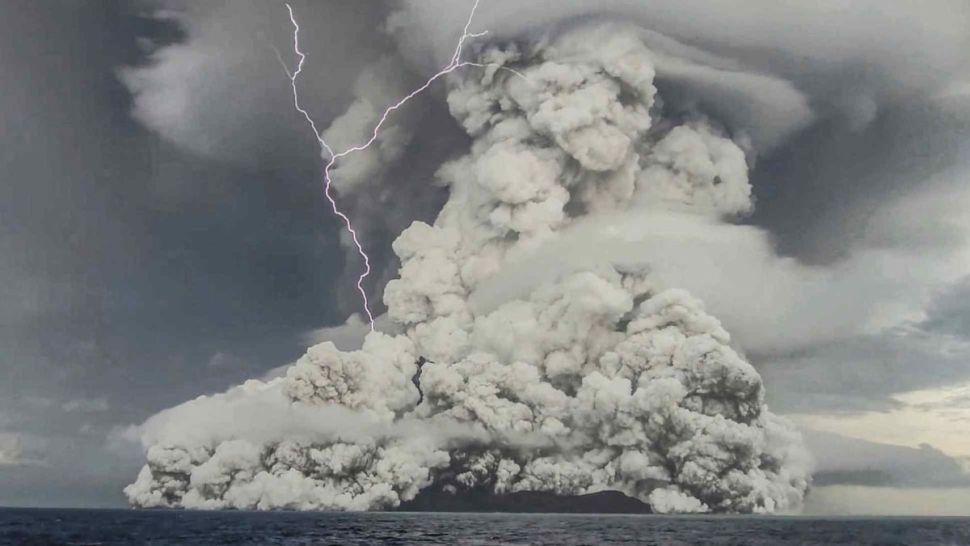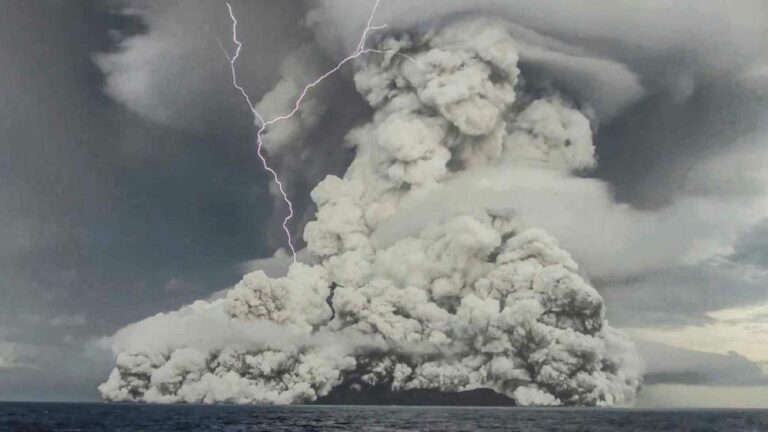Earth might receive years of warming from Tonga’s eruption’s 50 million tons of water vapor.
The explosive event increased atmospheric water vapor by 5%
Scientists are still investigating the effects of the powerful explosion from the undersea volcano that erupted in Tonga on January 14 more than eight months later, and they are learning that it may have warmed the earth.

In addition to massive amounts of ash and volcanic gases, geologists recently estimated that the eruption of Hunga Tonga-Hunga Ha’apa released a stunning 50 million tons (45 million metric tons) of water vapor into Earth’s atmosphere. According to a new research, this large-scale vapor injection increased the quantity of moisture in the global stratosphere by around 5% and may have caused a cycle of stratospheric cooling and surface heating. These effects may last for several months.
Hunga Tonga volcano erupts Seen from space!
The eruption of Tonga peaked two days after it started on January 13 and was the most violent seen on Earth in decades . According to the National Oceanic and Atmospheric Administration, the explosion lasted for 162 miles (260 kilometers) and blasted pillars of ash, steam, and gas more than 12 miles (20 km) into the air (NOAA).
Large volcanic eruptions usually cause the earth to cool down by spewing sulfur dioxide into the upper atmosphere, which absorbs solar energy. According to the University Corporation for Atmospheric Research of the National Science Foundation, rock and ash particles can also momentarily chill the globe by obstructing sunlight . In this sense, massive volcanic eruptions that occurred on a large scale in the past may have influenced the Earth’s climate and caused mass extinctions millions of years ago.
Volcanoes’ ability to cool the globe has also been proved by recent eruptions. According to a previous article by Live Science, when Mount Pinatubo in the Philippines blew its summit in 1991, the powerful volcanic explosion’s aerosols decreased world temperatures by around 0.9 degrees Fahrenheit (0.5 degrees Celsius) for at least a year.
During the 1991 eruption of Mount Pinatubo, Tonga released around 441,000 tons (400,000 metric tons) of sulfur dioxide, or 2% of that quantity. The National Weather Service reports that Tonga‘s underwater volcanic plumes sent “substantial amounts of water” into the stratosphere, the region that lies between 31 miles (50 km) and 4 to 12 miles (6 to 20 km) above Earth’s surface, unlike Pinatubo (and most large volcanic eruptions, which take place on land) (NWS).
According to a recent study that was released on September 22 in the journal Science, underwater volcanoes may “extract major parts of their explosive energy from the interaction of water and hot magma,” which drives massive amounts of water and steam up the eruption column. The plume reached a height of nearly 17 miles (28 km) into the atmosphere within 24 hours after the eruption.
The scientists used information obtained from radiosondes, which were attached to weather balloons and sent into the volcanic plumes, to calculate the quantity of water in the plumes. The sensors on these instruments monitor temperature, air pressure, and relative humidity as they ascend through the sky and send that information to a receiver on the ground, according to the NWS.
With tens of millions of tons of Tonga’s moisture now drifting in the stratosphere, Earth’s surface will be heating up, but it is unknown by how much, the research found. Atmospheric water vapor absorbs solar energy and re-emits it as heat. Surface warming might continue “over the months to come,” the scientists warned, because it will take longer for this warming impact to disperse because the vapor is lighter than other volcanic aerosols and is less affected by gravity’s pull.
According to earlier studies into the eruption, Tonga spewed enough water vapor to fill 58,000 Olympic-size swimming pools, and this enormous volume of atmospheric moisture may have had a negative impact on the ozone layer.
These enormous amounts of water vapor could alter the chemical cycles that regulate stratospheric ozone, according to the scientists’ findings in the new study. However, “detailed studies will be required to quantify the effect on the amount of ozone because other chemical reactions may play a role as well,” they added.
Source: SpaceCom
Originally published on Live Science.
Do not forget to share your opinion with us to provide you with the best posts !




Thanks for sharing your thoughts
Regards